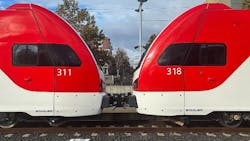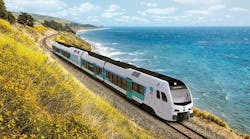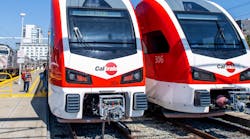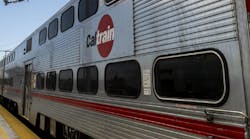Caltrain has completed 1,000 miles of testing along its corridor on three of its eventual 23 electric train sets. The entirety of the new fleet must meet all safety and quality standards prior to the launch of electrified service in fall 2024.
The 1,000-mile testing process is required to ensure all safety and quality standards are met to ensure the trains can safely operate on Caltrain’s tracks. The trainsets will continue to undergo additional testing before they can be deemed ready for passenger service in 2024. Caltrain currently has six train sets on property, with the remainder expected to arrive from the Stadler US manufacturing facility in Utah during the next year.
"Rigorous testing of equipment is how we make sure that our corridor remains safe for passengers and the communities we serve” said Caltrain Executive Director Michelle Bouchard. “I thank our crews for all their hard work testing these vehicles through the night while we continue to carry passengers during the day. I look forward to the rest of the new fleet going through the same safety testing process and for the rollout of this impressive fleet for our passengers later this year."
Caltrain’s Electrification Project is the first undertaking in North America in a generation in which diesel trains and their infrastructure components are transitioned to an electrified system. Electrification means faster and more frequent service, including doubling the frequency on weekends. The passenger experience will be greatly improved as well, with the new trains featuring Wi-Fi, power outlets at every seat, onboard displays with digital trip information and increased storage capacities.
Electrification will also help meet ambitious regional and state climate action goals by lowering greenhouse gas emissions, improving air quality and relieving traffic congestion. Additionally, electrified service will advance equity along the corridor by reducing noise and air pollution while increasing access for priority equity communities. It will also set the framework for California’s future high-speed rail network that will run on the Caltrain corridor.
Caltrain notes the proposed electrification service plan would see weekday peak hour trains go to 79 stations per hour, an increase from the current 66. Eleven stations would experience four train arrivals hourly per direction, an improvement from seven stations currently. Midday trains would cover 44 stations per hour, up from 34 today.
The electrification project coincides with the 160th anniversary of passenger rail service







